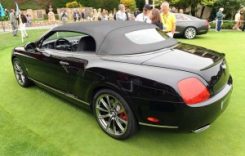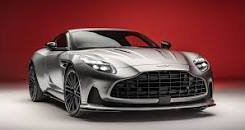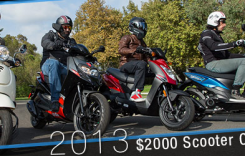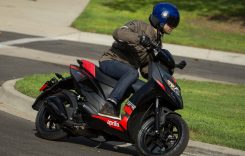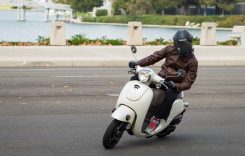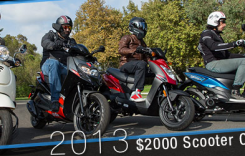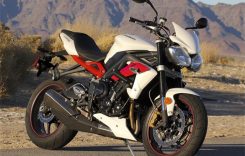Rather than mess with success Yamaha revives one of its greatest classics with the return of the kickstart-only SR400 ($5990). The modern SR builds upon Yamaha’s legendary quality delivering a simple yet thoroughly-engineered motorcycle that truly stands the test of time.

Like the Suzuki, the SR400 wears a more common UJM (Universal Japanese Motorcycle) shape from the ‘70s. Its design also integrates subtle bits from Britain’s café racer scene giving it a nice blend between the two genres. Take a closer look and it impresses with an excellent build quality. The most eye-catching components are the polished engine cases, deep Liquid Graphite paint, and the way the subtle hints of chrome tie the whole look together. Though it doesn’t turn heads like the Royal Enfield, it’s still a great looking ride.
Seated behind the handlebar the SR offers a natural and upright riding stance. It’s less demanding than the more sport-oriented Continental GT and as mini-bike-ish as the Suzuki. Its seat height (30.9 in.) is between the novice-friendly TU at 30.3 inches and the racier GT’s 31.5-inch height. On the scale, the Yamaha again positions between its rivals, weighing 38 pounds less than the RE, but 52 pounds more than the Suzuki. Still its extra heft was hard to notice.
“The Yamaha was my favorite of all three— perfect for my height,” says Ana who stands 5’9”. “The seat is like you’re on a cloud—it’s incredible. Seriously — we all did it— when you sit on it, it’s like ‘yaaay’ [posturing as if sitting on a fluffy pillow].”
In the comfort department the SR rated highly. From its well-proportioned ergonomics and smoother-running engine, the Yamaha is the motorcycle that invokes the most pleasurable experience on the road.
“Handling-wise I felt like the Yamaha probably won out,” thinks Melissa. “It felt pretty good on the twisty roads we were on, like I could actually lean on it and ride it decently hard. The Suzuki wasn’t bad— it just wasn’t quite as nice. The Royal Enfield was really a little sketchy feeling in some places. The only complaint with the handling on the Yamaha is at a higher speed it did feel a little wobbly. But it’s a little bike so it’s not that surprising.”
At a sporting pace, the Yamaha’s chassis flexes and isn’t as composed as the more firmly dampened GT. But if you can avoid kamikaze corner strafing missions, the SR handles just fine. The response from its disc/drum braking hardware was another minor strike as it proved the least effective, requiring the most distance to stop from 60 mph (156.4 feet). Braking sensation from the front disc wasn’t quite as sharp as the Suzuki’s set-up or the dual-disc equipped Continental.
“Very smooth—very easy to ride,” approves Ana. “Handles awesome on turns. Suspension is incredible— you don’t feel anything it absorbs everything and is very smooth… I have one complaint: the kickstart.”
(Top) Two of our three testers preferred the SR400 and said it’s the bike they would purchase in this contest. (Center) Simple and cozy. The Yamaha’s saddle was rated highly amongst our testers. (Bottom) The Yamaha offers better road holding at speed compared to the TU250X, however the chassis doesn’t feel quite as planted as the Royal Enfield’s.
Contrary to the e-start equipped Suzuki, or the Royal Enfield, which includes both electric and manual starting options, the Yamaha offers a kickstart-only. And while temporarily entertaining, after a few start/stops, the re-boot procedure does become a chore.
“It took me a little while to start it. I guess it’s a technique,” smiles Ana. “I guess if you are on a longer ride it’s wonderful because you don’t have to stop and go all the time and restart the bike. If you go for a coffee or something here and there it becomes very tiring to have to restart the bike like this every time.”
“At first the starting procedure was kind of cool because you don’t see many bikes on the street that you have to kickstart. So I thought that was kind of snazzy and made me feel like a bad ass,” Melissa adds. “But it does get a little old actually—having to get the crank in the right spot and kick it and then if you don’t get it to start right away start the whole procedure over again. I could see how that would get pretty old. It would be nice to have as an option a nice electric button also.”
Once lit, the engine runs cleanly and isn’t prone to stalling. The Yamaha has a functional gearbox and clutch, however it rated behind the more precise-feeling Suzuki. The engine delivers a steady stream of torque from just over 2000 revs all the way to its 7000 rpm redline. Its 19.94 lb-ft (second-highest) peak arrives at a relatively lofty rpm—at least compared to the tractor-like Royal Enfield but comes earlier than the Suzuki thus proving the most useable. In terms of horsepower, the SR narrowly outgunned the 136cc larger Continental and doles seven hp extra against the smaller Suzuki.
The SR sprints to 60 mph in the shortest time (8.6 seconds), and is the quickest across the quarter mile (16.74 seconds @ 77.5 mph). While we preferred the performance of the engine, it sounds more muffled and not as lively as the attention-grabbing Indian bike. If you’re seeking to go unnoticed though, the Yamaha is the bike, tying the Suzuki for the least amount of exhaust noise.
Fuel mileage-wise the Yamaha recorded just short of 50 mpg—positioning it between the miserly TU and the more thirsty RE. But factor in its more limited 3.2-gallon capacity (identical as the Suzuki) and the SR offers the shortest range between fill-ups.
Yamaha SR400 Highs & Lows
Highs
- Versatile engine performance
- Excellent ergos and comfort
- Top notch build quality
Lows
- No electric start
- Could have stronger brakes
- Loose handling at spirited canyon speeds
“It’s all-around a good bike… other than having to kickstart it,” sums up Melissa. “It makes pretty good power— it feels put together well. You can ride it pretty hard for what it is and it was just fun.”
You’ll be hard pressed to find a 30-year-old motorcycle that rides as nicely as this Yamaha. Despite being a pain to start during stop-and-go rides, its engine is the most flexible on the road. It also offers the highest degree of comfort while maintaining the pleasing attributes of an old motorcycle. However the absence of e-start along with its second-most expensive price tag allowed the under-gunned Suzuki to tie it for first place.
